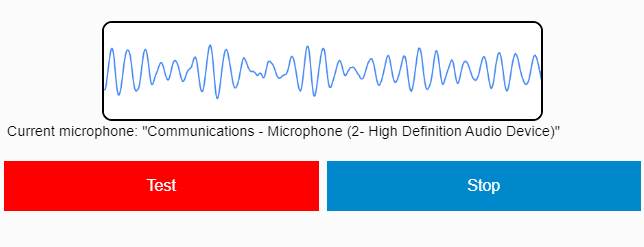ТЕСТ МИКРОФОНА
Use this online mic test tool to check and test the working of your microphone
инструкции (Для проверки микрофона):
- Щелкните значок 'Тестовое задание' Кнопка.
- Нажмите «Разрешить», если вы видите вопрос в браузере.
- Теперь линия должна двигаться, когда вы говорите через микрофон!
Если линия реагирует на звуки, значит, микрофон работает!
How our Microphone Testing Tool is Safe to Use?- (Your Privacy Is Very Important To Us)
Наш инструмент проверки микрофона работает на основе конфиденциальности, т.е. "сторона клиента" – это означает, что группа по тестированию микрофонов не записывает и не может записывать ваши голоса или любую другую информацию.
Having Trouble with using our microphone testing tool? Read Further to properly test your microphone.
Вы не можете протестировать микрофон онлайн с помощью этого инструмента? Вот пошаговое руководство, которое поможет вам легко выполнить тест микрофона.
* Если вы посетили сайт тестирования микрофона в первый раз или после очистки истории, ваш браузер попросит вас разрешить этому сайту доступ к вашему микрофону. Выберите Разрешить, чтобы выполнить онлайн-тест микрофона.
* Если у вас есть ПК / ноутбук, этот вопрос должен быть очень близко к адресной строке в верхней части экрана.
* Хорошо, если у вас есть мобильное устройство, прокрутите его до конца. Появится выбрать Разрешать.
* Теперь попробуйте сказать что-нибудь в микрофон, чтобы наш инструмент выполнил проверку микрофона. После этого вы сможете видеть линию, движущуюся вверх и вниз в области тестового поля, всякий раз, когда ваш микрофон слышит какой-либо звук, например:

* Если вы могли видеть линию, движущуюся вверх и вниз, когда вы говорите или говорите в микрофон, значит, ваш онлайн-тест микрофона прошел успешно. Ваш микрофон настроен правильно.
Руководство по устранению неполадок при тестировании микрофона
Если после разрешения доступа к микрофону вы не видите ни одной строки, попробуйте выполнить следующие действия:
Шаг 1. В некоторых случаях вы не увидите линии при тестировании микрофона. В этом случае говорите в микрофон относительно громче и посмотрите, появляется ли линия.
Шаг 2. Обновите страницу и попробуйте еще раз. В большинстве случаев это устраняет проблему.
Шаг 3. Если вы не можете узнать, работает ли ваш микрофон после выполнения обоих шагов, показанных выше, проверьте, правильно ли ваш микрофон подключен к вашему устройству.
Если вы видите линию, но линия не движется, значит, ваш микрофон сломан или неправильно настроен (больше шансов).
Попробуйте выполнить следующие действия, чтобы решить проблему:
Шаг 1. Если вы используете Safari в качестве веб-браузера, вам следует открыть этот веб-сайт для тестирования микрофона в другом браузере, таком как Google Chrome, Microsoft Edge.
Шаг 2. Затем убедитесь, что ваш микрофон подключен к правильному (обычно розовому) разъему на вашем ноутбуке / компьютере. Если это микрофон, используемый с разъемом USB, проверьте, правильно ли он подключен к разъему USB (пожалуйста, не используйте розовый микрофон в этом случае).
Шаг 3. Затем убедитесь, что ваш микрофон не отключен.
Шаг 4. И последнее, но не менее важное: убедитесь, что уровень громкости микрофона увеличен.
Пробовали провести тест микрофона онлайн, но микрофон все равно не работает? Вот несколько решений для вас:
Ваш микрофон для windows 7 или windows 10 не работает? Что ж, вы можете легко устранить неполадки в настройках микрофона в своей операционной системе, и микрофон будет работать нормально.
Как изменить настройки микрофона в Windows 10
Как изменить настройки микрофона в macOS
Как изменить настройки микрофона в Windows 8
Как изменить настройки микрофона в Windows 7
Как изменить настройки микрофона в Ubuntu (Linux)
Узнайте больше об онлайн-тесте микрофона
Какая польза от проведения онлайн-тестирования микрофона с помощью этого сайта?
Если вы используете такие приложения, как Skype или Discord, их функция тестирования микрофона может оказаться бесполезной, и вы можете не знать, работает ли ваш микрофон. Эти приложения предназначены для разных целей, и поэтому они не могут хорошо провести тест микрофона.
Однако, используя наш онлайн-инструмент для тестирования микрофона, вы можете легко проверить свой микрофон за секунды, чтобы мгновенно исключить проблемы с подключением микрофона.
В чем проблема с программным тестированием микрофона?
Проблема с тестированием вашего микрофона с помощью программного обеспечения, которое, похоже, не слышит ваш микрофон, заключается в том, что вы не можете быть уверены, в программном обеспечении или в вашем микрофоне.
Что делать, если мой микрофон не работает в некоторых программах?
Если вы смогли выполнить онлайн-тест микрофона на этом веб-сайте и обнаружили, что ваш микрофон работает, но он по-прежнему вызывает проблемы в стороннем программном обеспечении, мы рекомендуем вам обратиться в службу поддержки этого программного обеспечения.
Убедитесь, что вы сказали им, что ваш микрофон работает нормально, на сайте themictest.com, чтобы быстро решить вашу проблему.
Вы также можете проверьте свою веб-камеру если вы используете какие-либо приложения для записи видео, такие как Skype.
Ищу лучший микрофон для Discord - кликните сюда.
Самые дорогие микрофоны в ваших гаджетах или нет? Посмотрите здесь 7 самых дорогих микрофонов в мире
